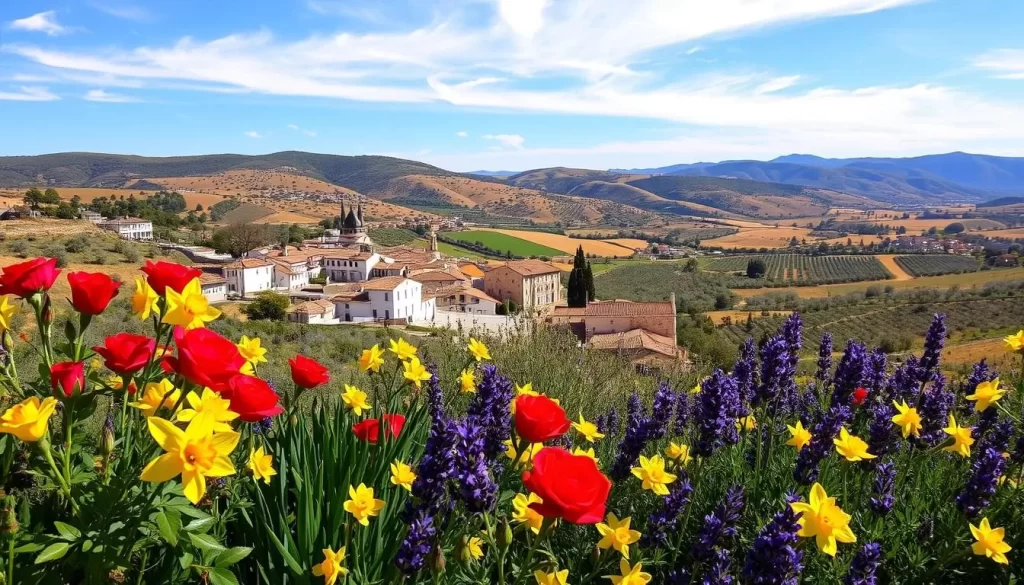✓ Accommodations✓ Flights✓ Rental Cars✓ Tours & Activities
Planning a trip to Spain can be challenging due to its diverse climate patterns. The country’s unique geography creates distinct weather zones, ranging from the rainy northern coast to the scorching southern plains.
Understanding the seasonal patterns is crucial to making the most of your travel experience. With over 300 days of sunshine per year, Spain is an attractive destination for travelers seeking pleasant temperatures and favorable weather conditions.
To determine the best time to visit, you’ll need to consider the regional variations in weather and time of year. This guide will help you plan a weather-savvy trip, ensuring you make the most of your Spanish adventure.
Understanding Spain’s Diverse Climate Regions
Understanding the diverse climate regions of Spain is crucial for planning a weather-savvy trip. Spain’s climate varies dramatically across its diverse regions, creating distinct weather patterns.
Northern Spain: Atlantic Influence
Northern Spain, including regions like Galicia, Asturias, and the Basque Country, experiences an Atlantic climate with mild summers and wet winters. This makes late spring and early fall the best times to visit.
Mediterranean Coast: Sunny and Mild
The Mediterranean coast, encompassing areas such as Valencia, Murcia, and coastal Andalusia, enjoys abundant sunshine year-round. It’s perfect for beach vacations from May through October.
Central Spain: Continental Climate
Central Spain, including Madrid and Castilla-La Mancha, has a continental climate with extreme temperature variations. Spring and fall are the most comfortable seasons to visit.
Southern Spain: Warmest Year-Round
Southern Spain, particularly cities like Seville and Cordoba, boasts the warmest year-round temperatures in continental Europe. Summers can be extremely hot, reaching 110-120°F.
Understanding these regional climate differences helps you select the ideal destination within Spain based on when you plan to travel. Each climate zone offers unique advantages depending on your weather preferences and planned activities.
Spring in Spain: March to May
Spain in spring is a treat for the senses, with comfortable temperatures, blooming landscapes, and a plethora of cultural events. As the country transitions from winter to warmer months, the weather becomes increasingly pleasant, making it an ideal time to visit.
Temperature and Precipitation Patterns
During spring, Spain experiences a gradual warming trend. March starts with cooler temperatures, ranging from the 50s to 60s°F, with occasional rain, particularly in the northern regions. By April, most of Spain enjoys delightful weather with decreasing precipitation and temperatures climbing into the 60s-70s°F across most regions. May brings near-perfect conditions throughout the country, with warm, sunny days ideal for outdoor activities and temperatures reaching the 70s-80s°F in southern regions.

Regional Weather Variations
Spring weather in Spain varies significantly across different regions. The southern coastal areas enjoy milder temperatures, making them suitable for beach days, while cities like Madrid and Barcelona experience comfortable conditions for city exploration. Understanding these regional variations can help you plan your trip effectively.
| Region | March | April | May |
|---|---|---|---|
| Northern Spain | 50s-60s°F, Rain | 60s°F, Decreasing Rain | 60s-70s°F, Sunny |
| Southern Spain | 70s°F, Mild | 70s-80s°F, Pleasant | 80s°F, Warm |
| Central Spain | 50s-60s°F, Cool | 60s-70s°F, Mild | 70s-80s°F, Warm |
Spring Festivals and Cultural Events
Spring in Spain is not just about the pleasant temperatures; it’s also a time for vibrant festivals and events that showcase the country’s rich culture. You can experience Seville’s famous April Fair (Feria de Abril), Córdoba’s Patio Festival, and Holy Week (Semana Santa) celebrations throughout the country. These events offer a unique glimpse into Spanish traditions and are a great way to immerse yourself in the local culture.
Summer in Spain: June to August
When summer arrives in Spain, you’re in for a treat of sun, heat, and vibrant cultural events. The country transforms into a sun-kissed destination, with the south being particularly hot.
Heat Waves and Coastal Breezes
Summer brings intense heat across Spain, with significant regional variations. While inland areas swelter, coastal regions enjoy relief from sea breezes, making beach destinations along the Mediterranean and Atlantic coast popular escapes.
Regional Temperature Differences
Temperatures soar in July and August, often reaching 90-100°F. Inland cities like Seville and Córdoba can experience extreme heat, sometimes hitting 110-120°F during the day.
| Region | Average High Temperature (°F) | Characteristics |
|---|---|---|
| Inland Andalusia | 110-120 | Extreme heat |
| Coastal Areas | 80-90 | Relieved by sea breezes |
| Central Spain | 95-105 | Hot and dry |
Summer Crowds and Tourism Impact
Summer is high season for tourism, especially in beach destinations, resulting in larger crowds and higher prices. Many Spaniards vacation in August, making coastal towns busy with domestic tourists.
Fall in Spain: September to November
As the summer heat dissipates, Spain transforms into a haven of pleasant weather during the fall season. This period, spanning from September to November, offers a unique blend of comfortable temperatures, fewer crowds, and a rich tapestry of cultural events.
Pleasant Temperatures and Changing Seasons
During September, the weather remains warm, with temperatures in the 70s-80s°F, making it perfect for swimming in the Mediterranean. As October progresses, daytime temperatures become comfortable, ranging from the 60s-70s°F, accompanied by the vibrant colors of changing landscapes.
Regional Weather Patterns
The weather varies across regions in the fall. While southern Spain enjoys mild conditions, northern regions experience cooler temperatures and increased rainfall by November.
Fall Festivals and Harvest Events
Fall is a time for numerous festivals and harvest events, including wine harvests and All Saints’ Day traditions. You can enjoy authentic experiences, easier access to attractions, and better accommodation rates during this season.

Winter in Spain: December to February
Winter in Spain brings a unique blend of mild coastal weather and snowy mountain landscapes. This diversity creates a range of experiences for travelers, from enjoying mild temperatures and sunshine in the south to experiencing a white Christmas in the northern mountains.
Mild Coastal Winters vs. Mountain Snow
The contrast between Spain’s coastal and mountainous regions is particularly pronounced during winter. While coastal areas like Barcelona and Valencia enjoy mild temperatures, the Pyrenees and Sierra Nevada mountains receive significant snowfall, making them perfect for skiing and snowboarding.
| Region | Typical Winter Temperatures | Weather Conditions |
|---|---|---|
| Coastal Mediterranean | 50s-60s°F | Mild, sunny |
| Southern Spain | 60s°F | Warm, abundant sunshine |
| Central Spain | 40s-50s°F | Colder, occasional frost and snow |
| Northern Mountains | Below 40°F | Snowy, ideal for skiing |
Regional Temperature Variations
Regional temperature variations play a significant role in shaping the winter experience in Spain. The southern region of Andalusia and the Canary Islands enjoy warmer temperatures, often reaching the 60s°F during the day, while central Spain, including Madrid, experiences colder winters with temperatures ranging from the 40s to 50s°F.
Winter Holidays and Celebrations
Winter in Spain is not just about the weather; it’s also a time for festive celebrations. Christmas markets, Three Kings Day on January 6th, and various regional winter festivals add to the country’s charm during this low season, making it a great time to experience local culture without the crowds.
Spain: Best Months for a Weather-Savvy Trip
Traveling to Spain at the right time can significantly enhance your experience, with pleasant weather and manageable tourist numbers. The country’s diverse climate regions mean that the best months to visit vary depending on your destinations and preferences.
Optimal Months for Different Regions
Different regions in Spain have optimal visit times based on their unique climate characteristics. For the Mediterranean coastal areas, the periods of May-June and September-October are ideal, offering warm temperatures without the peak summer heat and crowds.
- Mediterranean coastal regions: May-June and September-October
- Northern Spain: June through September for lower rainfall and pleasant temperatures
- Central Spain, including Madrid: April-May and September-October for moderate temperatures
- Southern Spain: March-May and October-November to avoid scorching summer temperatures
Balancing Weather, Crowds, and Prices
The shoulder seasons, specifically April-May and September-October, generally offer the best overall experience throughout Spain. These periods combine pleasant weather with fewer crowds and lower prices, making them ideal for travelers seeking a balanced experience.
| Region | Best Months | Characteristics |
|---|---|---|
| Mediterranean Coast | May-June, September-October | Warm temperatures, fewer crowds |
| Northern Spain | June-September | Lower rainfall, pleasant temperatures |
| Central Spain (including Madrid) | April-May, September-October | Moderate temperatures, comfortable sightseeing |
| Southern Spain | March-May, October-November | Avoids scorching summer temperatures |
Shoulder Season Advantages
Visiting Spain during the shoulder season can be particularly advantageous. You can enjoy pleasant weather, fewer tourists, and lower prices, making for a more relaxed and economical trip.
Avoiding Tourist Crowds: Strategic Timing
You can have a more authentic Spanish experience by steering clear of the crowds that flock to popular destinations during peak season. Understanding the dynamics of tourist flow can significantly enhance your travel experience.
Peak vs. Off-Peak Seasons
Spain’s tourist season peaks from mid-June through August, with July and August being the busiest months. In contrast, the off-peak season, particularly November through February (excluding Christmas and New Year’s), offers a serene experience with fewer tourists.
Regional Crowd Patterns
Regional crowd patterns vary; coastal areas are busiest in summer, while cities like Barcelona and Madrid see peaks in both summer and during spring/fall weekends.
Benefits of Low Season Travel
Traveling during the low season has its advantages, including lower prices, more personalized service, and better photography opportunities due to fewer people. Here’s a comparison of what you can expect during different times of the year:
| Time of Year | Crowd Levels | Prices | Experience |
|---|---|---|---|
| Peak Season (June-Aug) | High | High | Busy, less personalized |
| Shoulder Season (Apr-May, Sep-Oct) | Moderate | Moderate | Balanced |
| Low Season (Nov-Feb) | Low | Low | Serene, personalized |
By choosing the right time to visit, you can enjoy a more relaxed experience, taking in the beauty and culture of Spain without the hustle and bustle of tourist crowds.
Packing Essentials for Spanish Weather
To make the most of your Spanish adventure, it’s essential to pack according to the country’s diverse weather patterns. Spain’s climate varies significantly across regions and seasons, making it crucial to be prepared.
Layering for Spring and Fall
During spring and fall, the weather can be quite unpredictable, with significant temperature fluctuations between mornings, evenings, and midday. Layering is key during these seasons. Pack light, breathable clothing that can be layered with cardigans, light jackets, and scarves to adapt to the changing temperatures.
Protecting Against Summer Heat
Summer in Spain can be quite hot, especially in the central and southern regions. To protect yourself from the intense sun, prioritize lightweight, breathable fabrics, wide-brimmed hats, quality sunglasses, and high-SPF sunscreen.
Winter Essentials by Region
Winter packing varies dramatically by region. For southern Spain, a medium-weight jacket may suffice, while northern and central regions require warmer coats, scarves, gloves, and waterproof footwear. Don’t forget a compact travel umbrella, as rain can occur in any season, especially in the north.
| Season | Essential Items |
|---|---|
| Spring/Fall | Layers, light jacket, scarf, umbrella |
| Summer | Lightweight fabrics, sunscreen, sunglasses, hat |
| Winter | Warm coat, gloves, scarf, waterproof footwear, umbrella |

Regardless of the season, comfortable walking shoes are a must, as Spain’s cities and historic sites involve considerable walking on cobblestone streets and uneven surfaces. Spaniards tend to dress more formally than many tourists, so including some smart-casual options in your luggage will help you blend in at restaurants and cultural venues.
Cultural Events and Festivals by Season
From spring to winter, Spain hosts a diverse array of cultural events and festivals that showcase its rich heritage. Each season brings unique celebrations that highlight the country’s vibrant culture and traditions.
Spring Celebrations
Spring in Spain is marked by significant events like the Holy Week (Semana Santa) processions in April, particularly in Andalusian cities such as Seville and Málaga. The Feria de Abril in Seville is another highlight, featuring flamenco dancing and traditional costumes. Additionally, Las Fallas in Valencia (March) and Sant Jordi Day (April 23) in Catalonia are notable spring events.
Summer Festivals
Summer is the season for numerous festivals across Spain. The Running of the Bulls during San Fermín in Pamplona (July) and La Tomatina tomato fight in Buñol (August) are world-famous events. Many towns also hold their “fiestas mayores” during summer, showcasing local traditions and music.
Fall and Winter Traditions
Fall celebrations include wine festivals in La Rioja and Jerez, and mushroom foraging events in northern regions. Winter brings Christmas markets, elaborate Nativity scenes, and the Three Kings Day parade on January 5. Regional winter festivals include carnival celebrations in Cádiz and Tenerife.
| Season | Notable Events | Locations |
|---|---|---|
| Spring | Holy Week, Feria de Abril | Seville, Málaga |
| Summer | Running of the Bulls, La Tomatina | Pamplona, Buñol |
| Fall | Wine Festivals | La Rioja, Jerez |
| Winter | Christmas Markets, Three Kings Day | Various regions |
Budget-Friendly Travel: Weather and Pricing
Visiting Spain during the shoulder season can provide the best balance of pleasant weather and reasonable prices. By choosing the right time to travel, you can enjoy lower prices, fewer crowds, and a more authentic experience.
Seasonal Price Variations
Accommodation prices in Spain can vary significantly between high and low seasons, with coastal areas experiencing the most dramatic price differences. Understanding these fluctuations can help you plan a budget-friendly trip.
Weather-Price Balance
The shoulder seasons, May-June and September-October, offer pleasant weather and reasonable prices, with rates typically 20-30% lower than peak summer months. You can enjoy comfortable temperatures and lower prices during these periods.
Off-Season Deals and Discounts
Winter travel, excluding Christmas and New Year’s, provides the most significant savings, with hotel rates often 40-60% lower than summer prices. You can also find discounted flight prices and package deals during the off-season.

To make the most of your trip, consider booking flights and accommodations in advance to secure better rates. Mid-week travel and off-season deals can also help you save money.
Conclusion
Spain is a year-round destination, offering diverse experiences that cater to various traveler preferences. Whether you’re seeking beach time, cultural immersion, or outdoor adventures, the best months for your trip depend on your specific interests.
Spring (March-May) and fall (September-November) generally offer the best balance of pleasant weather, fewer tourist crowds, and reasonable prices across most of Spain. In contrast, summer months (June-August) are ideal for beach vacations, while winter (December-February) provides excellent value with the lowest prices and fewest tourists.
By considering the seasonal information, you can time your visit to align with your weather preferences, budget constraints, and desired activities. Spain’s warm hospitality, rich culture, and stunning landscapes ensure a memorable trip for weather-savvy travelers. Don’t forget to pack accordingly, whether it’s sunscreen for sun-drenched beaches or layers for cooler mornings and evenings.
The above is subject to change.
Check back often to TRAVEL.COM for the latest travel tips and deals.






